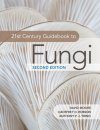"21st Century Guidebook to Fungi describes the fungal story with art and excellence. This guidebook is authored by three recognized fungal experts to whom I was privileged to meet. It has everything one wants to find in a book; it is easy to read, it has informative headings, well-organized tables and illustrative figures, and it contains all one wants to know about the matter. Definitely, this is an invaluable book that all those passionate about fungi must have!"
– Carmen Sánchez, Autonomous University of Tlaxcala, Mexico
"This is a comprehensive wide-ranging survey of the Fungal Kingdom of proven value to all interested in fungal biology. The scope is huge ranging from ecology and environment through biodiversity, growth, cell biology, biochemistry, molecular biology and genetics to pathogenesis and biotechnology. Building on the earlier format, the Second Edition is significantly updated with major recent developments in fungal biology including genomics, proteomics, bioinformatics and computational biology. The layout of text and figures is excellent with the writing style clear and 'user-friendly'. The content is supported by a thorough web-based resource as well as numerous web-links and relevant references for each topic to guide readers to in-depth knowledge. Useful appendices provide clear accounts of taxonomy and differentiation. The book is invaluable for teachers and students of fungal biology, microbiology and related disciplines as well as researchers requiring broad background knowledge of fungal systems."
– Geoffrey l Gadd, University of Dundee
"This well-illustrated and fully revised new edition provides a masterly, enticing, and fascinating window into the mysteries and marvels of the biology and physiology of fungi; their life-styles, how they develop and grow, their chemical armory, beneficial and harmful interactions with diverse other organisms, ecological roles, and importance to human well-being. Fungi often go unseen and so unappreciated, but they touch so many aspects of our daily lives. Original sources and websites are cited throughout which greatly facilitates further enquiry. The authors have spent their careers teaching mycology at the university level, and have produced a book that will continues to be a boon to not only those taking postgraduate courses involving fungi, but a starting point for anyone keen to explore the capabilities and importance of these often unappreciated but intriguing organisms in more depth."
– David L. Hawksworth, CBE, Royal Botanic Gardens Kew, UK; Honorary President, International Mycological Association
"Fungi encounter us daily in our lives, sometimes consciously as in baking and brewing, while their immense prevalence and importance often remain unnoticed. Fungi may be perceived as evil, through molds on our food, pathogens on crops and sources of disease. However, fungi have distinct environmental roles in symbiotic and parasitic actions and in competitions for nutrients and space. They contribute significantly to transformation and preservation of ecosystems and biodiversity, on smaller and larger scales in all types of habitats. Fungi recycle organic material including wood enabling renewal of plant growth. They protect themselves and others by antibiotics to suppress competitors in warfare. They use chemical and enzymatic strategies to attack dead and living organic material exploited in modern biotechnology. Knowledge and views on fungi have changed dramatically with the contemporary 'omics' research and molecular-based taxonomy and are comprehensively featured in this highly informative, up‑to-date and multi-facetted fungal book."
– Ursula Kües, University of Göttingen
"I highly recommend this textbook. It has very broad coverage of the subject area of fungal biology from cell and molecular, through to whole organism and ecological and applied aspects. It is suitable for undergraduate and postgraduate students, indeed I provide copies as essential background reading to my postgraduate students to give them an overview of the field. The text is very well laid out, beautifully illustrated and clearly explains the material, reflecting the longstanding experience of the authors as University teachers. Of particular credit is the integration of cell biology, biochemical and genomic data, combined with thorough details of the use of fungi in biotechnology and their importance as both beneficial symbionts but also detrimental pathogens. I am delighted that a new edition of the text has been produced, with updates and online resources maintaining the guidebook as the best all round mycology text available."
– Paul S. Dyer, University of Nottingham


































